Whale Watching Big Island: Top Tips & Best Tours
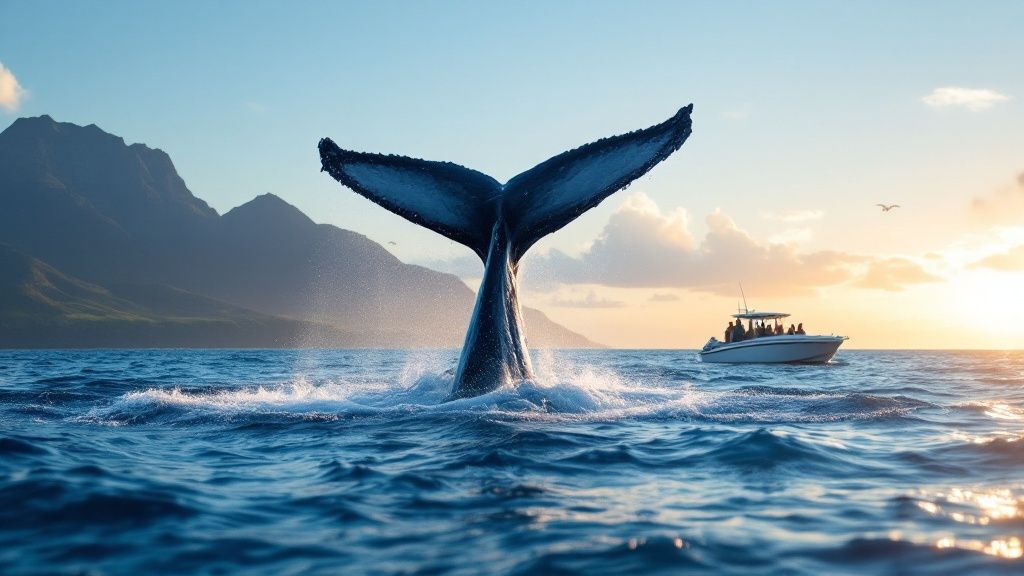
If you want to see whales on the Big Island, you’ve got to be here between December and April. That’s when thousands of humpback whales make their way to Hawaii’s warm waters. For the absolute best odds of seeing these giants leap from the ocean, plan your trip for the peak season in January and February.
As Hawaii's top-rated and most-reviewed snorkel company, we at Kona Snorkel Trips live for sharing these unforgettable and responsible ocean adventures.
Your Guide to Big Island Whale Watching
Every winter, something truly magical happens off the coast of the Big Island. The calm, protected waters become a nursery and a playground for North Pacific humpback whales. They travel thousands of miles to get here to breed, give birth, and raise their young, putting on one of nature’s most incredible shows. This yearly migration is a massive event, and people come from all over the world to witness it.
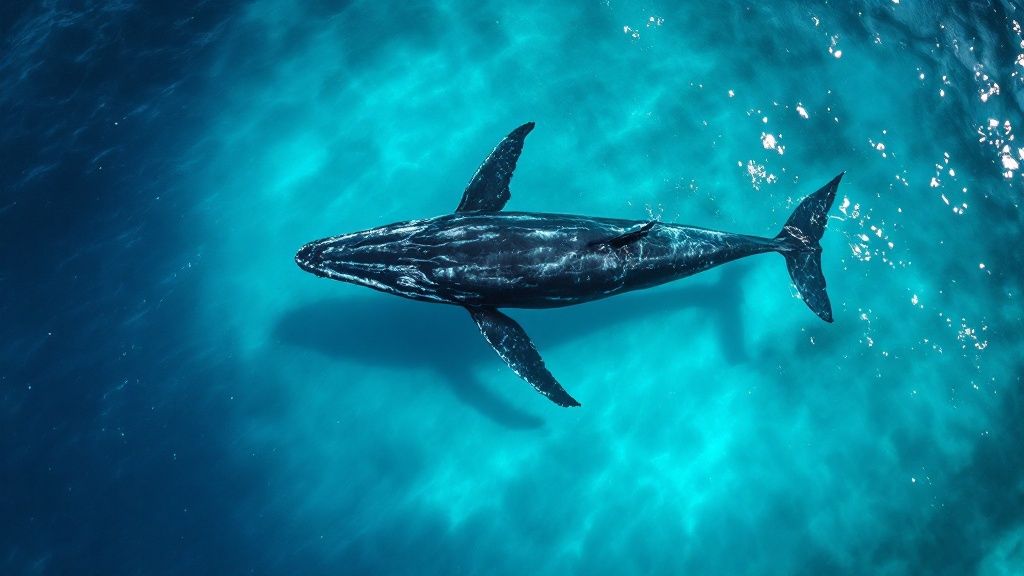
The Great Migration to Hawaii
The journey these whales make is astounding. The entire North Pacific humpback population, which is around 26,000 individuals, travels roughly 3,000 miles from their chilly feeding grounds up in Alaska. It’s one of the longest migrations of any mammal on Earth, and it brings them right to our doorstep.
It’s also a powerful conservation success story. After being nearly wiped out by commercial whaling, their numbers have made a remarkable comeback, thanks in large part to the Hawaiian Humpback Whale National Marine Sanctuary established in the 1990s.
The local community is deeply involved in keeping an eye on these gentle giants. During the Sanctuary Ocean Count on January 27, 2024, for example, volunteers spotted 324 humpbacks from 40 different spots along the shoreline. This kind of citizen science gives us priceless data and helps everyone appreciate the sheer scale of the migration.
What to Expect on a Whale Watching Tour
Getting out on the water with a professional tour isn't just a boat ride—it's your front-row seat to the action. It’s the safest and most respectful way to see a whole range of whale behaviors, from spectacular breaches to curious spy-hops. You can get a feel for what we offer on our specialized whale watching tours in Kona.
An experienced naturalist on board can completely change the experience. They don’t just point out whales; they explain what you're seeing, translating the behaviors and sounds into a story you can understand. It turns a great sightseeing trip into a fascinating educational adventure.
In this guide, we’ll walk you through everything you need to know for a successful trip, covering:
- The best times and places to go for the most sightings.
- What all those breaches, tail slaps, and spouts actually mean.
- How to pick the right tour for you and your group.
- A checklist of what to bring for a perfect day on the water.
Finding the Best Time and Place to See Whales
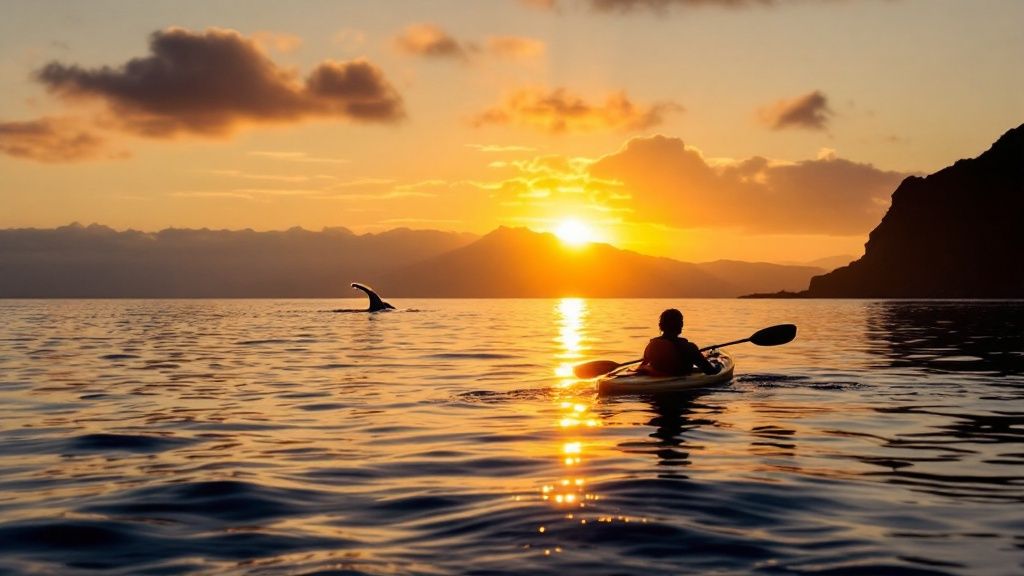
When it comes to whale watching on the Big Island, timing and location are everything. It’s the difference between catching a fleeting glimpse of a distant spout from the shore and finding yourself in the middle of all the action. While you might get lucky anywhere, getting out on the water during the right month and in the right spot dramatically stacks the odds in your favor for a truly unforgettable encounter.
The official whale season runs from December through April, but it’s helpful to think of it like a bell curve. The season starts slowly as the first humpbacks arrive, builds to a magnificent peak, and then gradually tapers off as the whales begin their long migration back to Alaska. Not all months are created equal.
Pinpointing the Peak Season
If you're looking for the absolute best time for a whale watching tour on the Big Island, set your sights on January and February. This is when the humpback population is at its highest density, and the waters are practically humming with activity. You'll see everything from massive males competing for mates to newborn calves learning to breach right alongside their mothers. It’s a spectacular sight.
Don't just take our word for it. Over two decades of data from the Sanctuary Ocean Count project, a volunteer-run census, consistently flags January and February as the peak. During this window, observers along the Kohala Coast have reported an average of 3 to 6 whales every 15 minutes. Fast forward to March, and that number can drop by 50%.
The shoulder months are still fantastic, though. December brings the exciting arrival of the first whales, with sightings becoming more frequent by the day. And in March and April, you’ll still see plenty of action, especially from mothers with their growing calves getting ready for the journey north. To get a closer look at what each month holds, check out our complete guide to the Big Island whale season.
The Undisputed Hotspot: The Kohala Coast
While whales can technically be spotted all around the island, the waters off the Kohala Coast are the undisputed epicenter. This protected leeward side, which includes the Kona and Waikoloa areas, offers the calm, clear, and warm waters that humpbacks seek out for mating and calving. The relatively shallow depths also create a perfect nursery, providing a safe haven from deep-water predators like orcas.
The evidence is clear: sightings along the Kohala Coast are often two to three times more frequent than anywhere else on the island. Plus, the calm conditions that attract the whales also happen to make for a much smoother and more enjoyable boat ride for you.
A couple of other areas are worth noting:
- The Hamakua Coast: This windward side sometimes sees an interesting uptick in sightings during March as some whales linger here before migrating.
- Hilo Bay: While less common, whales are occasionally spotted here, but the rougher sea conditions can make viewing a real challenge.
For the highest probability of seeing spectacular surface behaviors like breaches and tail slaps, the Kohala Coast during peak season is simply unmatched. The sheer concentration of whales in one area creates an energetic and dynamic environment you won't find anywhere else.
The Best Time of Day for Your Tour
Once you've locked in the right month and location, the final piece of the puzzle is deciding on the best time of day for your tour. The answer is almost always the morning.
The main reason comes down to the weather. The ocean is typically much calmer in the early hours, with glassy seas and less wind. This smooth surface makes it far easier to spot whale spouts, splashes, and their dark bodies against the water. As the day wears on, the trade winds tend to pick up, creating more chop and making it tougher to see what’s out there.
There's also evidence to suggest that whales are simply more active in the morning. Data shows that sightings around 8:00 AM are approximately 50% higher than those at midday. Booking a morning tour just gives you the best possible stage for seeing and photographing these incredible animals.
Big Island Whale Watching Season at a Glance
To help you plan, here's a simple breakdown of the whale watching season on the Big Island. This table gives you a quick snapshot of what to expect month by month, so you can choose the perfect time for your trip.
| Month | Whale Activity Level | Primary Viewing Location | Notes |
|---|---|---|---|
| December | Moderate | Kohala Coast (Kona/Waikoloa) | The first arrivals appear. Sightings become more consistent toward the end of the month. |
| January | Peak | Kohala Coast (Kona/Waikoloa) | The highest concentration of whales. Excellent chances for seeing lots of surface activity. |
| February | Peak | Kohala Coast (Kona/Waikoloa) | Activity remains at its peak. Prime time for seeing competitive pods and newborn calves. |
| March | High | Kohala Coast & Hamakua Coast | Still plenty of whales, with a noticeable increase in mother-calf pairs. |
| April | Moderate | Kohala Coast (Kona/Waikoloa) | The last of the whales depart for Alaska. A great time to see larger calves. |
Ultimately, planning your trip around the peak season and prime locations will give you the best chance for a whale watching experience that you'll remember for a lifetime.
Decoding Common Humpback Whale Behaviors
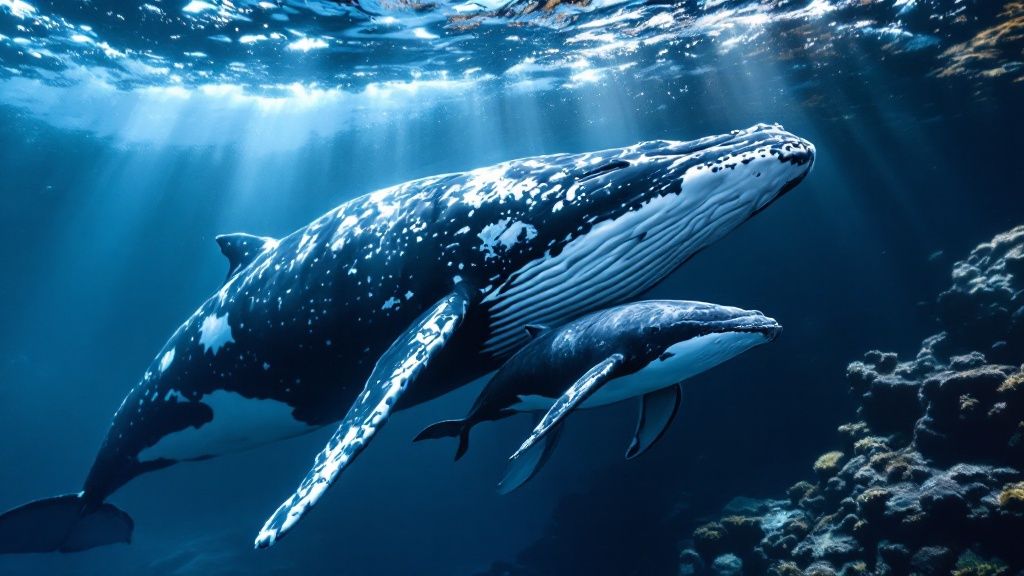
Seeing a humpback whale is one thing, but understanding what it's doing takes the experience to a whole new level. It's the difference between just watching a foreign film and actually understanding the dialogue. Every breach, slap, and spout tells a story, and once you start to recognize the patterns, you feel a real connection to these incredible animals.
When you're out on a whale watching tour on the Big Island, you're getting a front-row seat to some seriously complex social drama. These behaviors aren't random; they're a rich language of communication, play, and courtship. Learning to interpret them adds so much more depth to your time on the water.
The Iconic Breach
There's nothing quite like the breach. This is the showstopper—the moment a whale launches its entire 40-ton body into the air, twisting and crashing back down in an explosion of whitewater. It’s the single most powerful and breathtaking sight you can witness.
So, why do they do it? Honestly, we're still figuring it all out, but researchers have some good ideas. It could be a way to shake off stubborn barnacles, a raw display of strength to impress a mate, or maybe, just maybe, they do it for the sheer joy of it. Whatever the reason, a breach is a statement that can be seen for miles.
All The Slaps and Splashes
Humpbacks are masters of percussion. They use their massive bodies to create booming sounds that carry incredible distances underwater, which is crucial for communicating in the busy Hawaiian breeding grounds.
- Tail Slap (Lobtailing): This is exactly what it sounds like. The whale lifts its massive tail fluke out of the water and smacks it down hard, creating a sound like a cannon shot. Think of it as a warning sign or a way of saying "back off."
- Pectoral Slap (Pec Slap): Using those long, wing-like pectoral fins, a whale will roll on its side and repeatedly slap the water. This seems to be more of a social "hello" or a way to get another whale's attention.
- Peduncle Throw: This one is pure power. A whale will use its incredibly muscular peduncle (the part of the body right before the tail) to heave its entire back half out of the water and slam it down sideways. It's an aggressive move you often see when males are competing for a female.
The sound of a tail slap is something you feel as much as you hear. It’s a deep, resounding crack that reminds you just how powerful these gentle giants truly are. It’s a sound that demands respect.
Curious Peeks and Social Cues
Not every behavior is loud and splashy. Some of the most memorable encounters are the quieter ones that reveal the whales' curious and social nature.
One of my personal favorites is the spyhop. A whale will orient itself vertically and poke its head straight out of the water, sometimes rotating slowly to get a 360-degree view of its surroundings. It feels like they're just as interested in checking you out as you are in them. It's a truly magical moment of connection.
Then there's the head lunge. This is an aggressive move, usually seen in competitive pods of males, where one whale will lunge forward at another with its head. It’s a clear display of dominance, a way to establish the pecking order without anyone getting seriously hurt. Watching these intricate social dynamics play out is a highlight of the whale watching season on the Big Island.
How to Choose the Right Whale Watching Tour
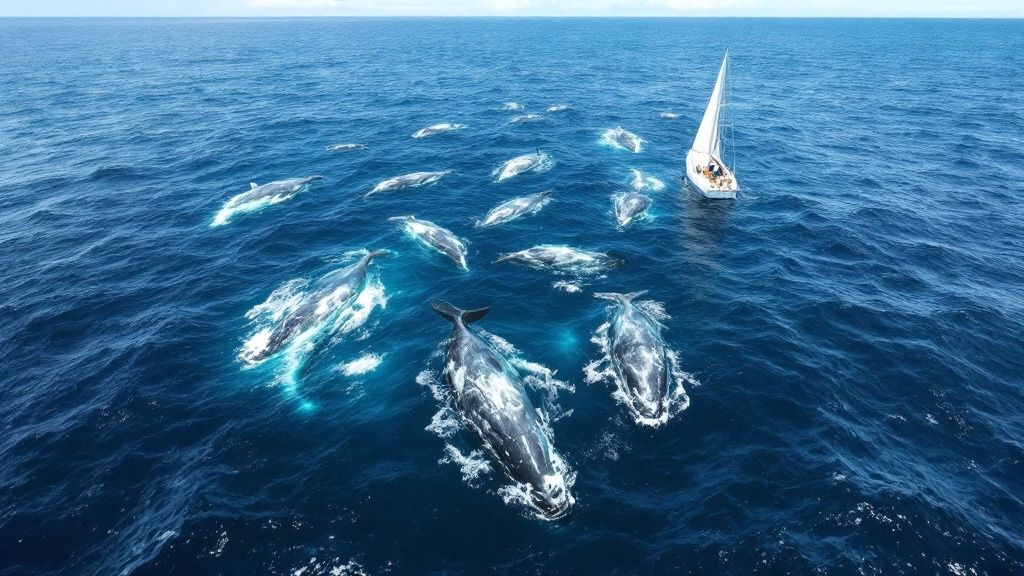
Picking the right tour for whale watching on the Big Island is just as crucial as choosing the right time of year. The boat you're on, the crew's expertise, and the company's commitment to the whales’ well-being all come together to shape your day on the water. A little homework upfront ensures your adventure is everything you hoped for—and more.
With so many operators out there, the choices can seem dizzying at first. But they mostly boil down to a few key types of boats, and each one offers a completely different kind of experience.
Comparing Whale Watching Tour Boat Types
The vessel you're on truly defines your perspective. A spacious, steady catamaran provides a very different outing than a zippy raft that puts you right at the water's edge. Neither one is better than the other; it’s all about matching the boat to the kind of day you want to have.
Choosing the right boat for your whale watching tour is a big decision. To make it easier, we've broken down the most common options you'll find on the Big Island.
Comparing Whale Watching Tour Boat Types
| Boat Type | Pros | Cons | Best For |
|---|---|---|---|
| Large Catamaran | Very stable, spacious, onboard restrooms, snack bars. | Larger groups, less intimate experience. | Families, those prone to seasickness, comfort-seekers. |
| Zodiac / Raft | Fast, exciting ride, close to the water level for great photos. | Bumpy ride, no amenities, can be wet. | Adventurous travelers, photographers, small groups. |
| Sailboat | Quiet and eco-friendly, relaxing and intimate experience. | Slower pace, reliant on wind conditions. | Couples, eco-conscious travelers, those seeking a peaceful experience. |
| Private Charter | Completely customizable itinerary, ultimate privacy. | Most expensive option. | Special occasions, serious photographers, groups wanting exclusivity. |
No matter which boat you choose, remember that the most important factor is the operator's commitment to the whales' safety and well-being.
Key Questions to Ask Before You Book
Once you have a boat type in mind, it's time to start looking at specific tour companies. Asking a few smart questions can tell you everything you need to know about the quality of the trip they offer. Don't hesitate to pick up the phone and chat with them.
A truly great tour is more than just a boat ride—it’s an educational journey that leaves you inspired. For a closer look at what separates the good from the great, check out our guide to the best whale watching tours in Kona, Hawaii.
Here are the essential questions to ask before you hand over your credit card:
- What is the experience of your captain and naturalist guide? A seasoned crew not only knows the whales' favorite hangouts but can also read their behavior, giving you insight into what you're seeing. A great naturalist on board can turn a simple sighting into a full-blown lesson in marine biology.
- Do you use hydrophones? This is a game-changer. A hydrophone is an underwater microphone that lets you listen in on the complex, haunting songs of male humpback whales. It adds an entirely new, unforgettable dimension to the experience.
- What is your policy on responsible wildlife viewing? Ask them directly how they respect the whales' space. A reputable company will be proud to tell you they strictly follow the 100-yard approach rule and other federal guidelines.
- How long is the tour and what is your success rate? Most trips run for 2-4 hours. In the heart of the season, any good operator should have a sighting success rate well over 90%. Many even offer a "sighting guarantee," meaning you can go again for free if you don't see any whales.
What to Pack for Your Whale Watching Trip
A little preparation goes a long way in making sure your whale watching tour is comfortable and memorable. Once you’re out on the water, you want to be focused on the whales, not wishing you’d brought a jacket or sunglasses. Planning ahead means you can just relax and enjoy the show.
Think of it like this: the ocean has its own set of rules. The weather can change in a heartbeat, going from warm and sunny to windy and cool. Dressing in layers is always your best bet.
Gearing Up for Sun and Sea
That beautiful Hawaiian sun is no joke, especially when it’s reflecting off the water right at you. Protecting yourself is priority number one, and it also helps protect the fragile marine environment you’re there to see.
- Reef-Safe Sunscreen: This is an absolute must. Your everyday sunscreen likely has chemicals like oxybenzone that are incredibly harmful to our coral reefs. Look for a mineral-based, reef-safe formula to keep both your skin and the ocean happy.
- Polarized Sunglasses: Honestly, these are a game-changer. They do more than just shade your eyes; they slice right through the water's glare, making it so much easier to spot a whale's spout in the distance or see its massive shape just under the surface.
- A Hat with a Chin Strap: A wide-brimmed hat is fantastic for sun coverage, but the ocean wind is a notorious hat-thief. A simple chin strap will keep your hat where it belongs—on your head.
Staying Comfortable on the Water
Beyond sun protection, a few other items will make a world of difference. It's all about being ready for anything.
Bring a light, waterproof jacket or windbreaker. Even on the warmest days, the breeze from the moving boat can get surprisingly chilly, and you never know when a quick rain shower might pass through. This one piece of clothing can be the difference between shivering and being perfectly comfortable.
And of course, don't forget your camera with a zoom lens. Your phone is fine, but if you want those incredible, frame-worthy shots of a whale breaching, a real camera with a good zoom is the way to go. A neck or wrist strap is also a smart move to keep it safe and secure.
Nothing can spoil a perfect day on the water faster than seasickness. Even if you think you have a stomach of steel, the constant, gentle roll of the ocean can get to anyone. It’s always better to be safe than sorry.
If you know you’re prone to motion sickness, think about taking an over-the-counter option like Dramamine or Bonine before you even leave the dock (just be sure to follow the instructions). For a non-drowsy approach, things like ginger chews or acupressure wristbands work wonders for many people. And a classic trick that always helps: keep your eyes fixed on the stable, unmoving horizon.
Practicing Responsible Whale Watching
Seeing a humpback whale leap from the water is a memory that sticks with you forever. It's a privilege, and it comes with a responsibility. These massive, gentle creatures are in Hawaii for the most important events of their lives: to find a mate, give birth, and nurse their newborn calves. Being a responsible whale watcher isn't just a nice idea—it’s absolutely critical to making sure they keep coming back.
The whole point of ethical whale watching is to minimize our disruption. Think of yourself as a quiet visitor in their nursery. You're there to observe, not to interfere. This mindset is the backbone of a healthy marine tourism industry, one that lets us marvel at these animals without harming them.
Following the Rules of the Ocean
To protect the whales, Hawaii has some very clear, legally-enforced rules. The single most important one to burn into your memory is the 100-yard minimum viewing distance. That’s the length of a football field, and it applies to everyone—boats, kayaks, paddleboards, and swimmers.
That number wasn’t just picked out of a hat. Studies have shown that getting any closer can seriously stress the whales, especially a mother trying to protect her calf. It can interrupt nursing, resting, and all the crucial behaviors a young whale needs to learn to survive. Getting inside that 100-yard bubble on purpose is illegal and comes with some hefty fines.
A great tour operator doesn't just know this rule; they live by it. They understand that the most magical encounters are the ones that happen on the whales' terms.
The Hawaiian Islands Humpback Whale National Marine Sanctuary
Much of the water where you'll be whale watching on the Big Island is more than just ocean—it's a federally protected marine sanctuary. The Hawaiian Islands Humpback Whale National Marine Sanctuary was created back in 1992 and covers about 1,400 square miles of the most important whale habitat around the islands.
The sanctuary has a few key jobs:
- Protection: It's a safe zone where whales can breed, calve, and nurse without harassment.
- Research: It's a living laboratory for scientists studying whale populations and the threats they face.
- Education: It teaches all of us why these animals are so important and how we can help protect them.
When you book a tour that follows the sanctuary's guidelines, you’re not just a tourist. You're actively supporting this massive conservation effort and helping keep the entire marine ecosystem healthy.
Choosing a tour operator committed to ethical practices is the single most impactful decision you can make. It sends a clear message that you value the well-being of the whales over getting a few feet closer. Your choice directly supports companies that invest in conservation and sustainable tourism.
How You Can Be an Ocean Steward
Your role as a responsible visitor doesn't end when the boat docks. The Hawaiian concept of mālama i ke kai—caring for the ocean—is something you can practice during your entire trip.
Here are a few simple ways you can help protect Hawaii’s incredible marine world:
- Choose Reef-Safe Sunscreen: Slather on mineral-based sunscreens. The chemical ones (with oxybenzone and octinoxate) are poison for our delicate coral reefs.
- Pack Out What You Pack In: Make sure every bit of your trash, especially plastics, makes it to a proper bin.
- Respect All Wildlife: Keep a respectful distance from all marine life, whether it's a sea turtle (honu) munching on algae or a pod of dolphins (nai'a) surfing the bow wave.
- Support Eco-Conscious Businesses: Spend your money with tour operators, restaurants, and shops that are genuinely committed to protecting the environment.
Every little bit helps. Your choices add up, preserving the magic of Hawaii for years to come.
Got Questions? We've Got Answers
Even the most seasoned traveler has questions before heading out on the water. Here are some of the most common things people ask about whale watching on the Big Island, along with some straight-to-the-point answers to get you ready for the adventure.
Is a Boat Tour Really Worth It, or Can I Just Watch from Shore?
You can definitely catch glimpses of whales from land, especially from high vantage points along the Kohala Coast. A distant spout or a surprise breach against the horizon is always a thrill.
But if you want to truly experience these animals, a boat tour is in a completely different league. There's just no substitute for being out on the water, feeling the scale of a 40-ton humpback as it surfaces nearby. A tour gets you to the heart of the action, and the insights from an experienced crew—plus the chance to hear whale songs through a hydrophone—add layers to the experience you simply can’t get from a clifftop.
What’s the Best Time of Day to Go?
If you have a choice, I always recommend the morning. The ocean tends to be much calmer, almost glassy, which makes for a smoother ride and makes spotting whales a whole lot easier. Plus, that soft morning light is a photographer's dream.
That said, don't sweat it if your schedule only fits an afternoon trip. Whales are active all day long. The most important thing is just getting out there, especially during the peak months. An afternoon tour can be just as mind-blowing, so book what works for you.
Pro Tip: While mornings often have the best water conditions, the key isn't the time of day but the time of year. Being on the water in January and February means you're surrounded by whales, and they're active from sunup to sundown.
Am I Guaranteed to Actually See a Whale?
In peak season, your chances are incredibly high. We're talking well over a 95% success rate for most reputable tour companies, particularly from January through February. There are just so many whales in the channel, it's hard not to see them.
Of course, these are wild animals, so nothing is ever 100% guaranteed. But look for operators that offer a "sighting guarantee." It's a sign of their confidence. This usually means if you strike out and don't see any whales, you can come back on another trip for free.
Can We Jump in and Swim with Them?
Absolutely not. This is a big one, and it’s for everyone’s safety—yours and the whales'. Federal law makes it illegal to intentionally get in the water with humpback whales in Hawaii. All boats, swimmers, and paddleboards have to stay at least 100 yards away.
These laws are in place for a good reason. The whales are here to breed and give birth, and a mother with a newborn calf is especially vulnerable. Disturbing them can be dangerous and harmful. The absolute best way to appreciate them is from the deck of a boat that knows and respects the rules.
Ready for an experience you'll never forget? At Kona Snorkel Trips, we're all about creating respectful, awe-inspiring, and safe encounters with these gentle giants. Book your tour today and see for yourself.
